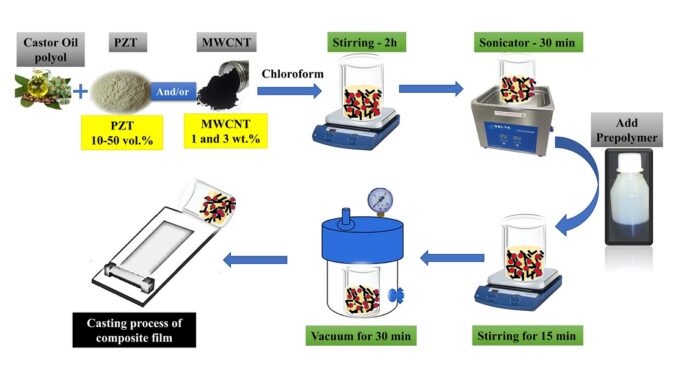
Dielectric, electric, and piezoelectric properties of three-phase piezoelectric composite based on castor-oil polyurethane, lead zirconate titanate particles and multiwall carbon nanotubes
Abstract: The effects of multiwall carbon nanotubes (MWCNTs) on the electrical, dielectric, and piezoelectric properties of the ferroelectric ceramic/castor-oil polyurethane (PUR) composite films were evaluated. The three-phase piezoelectric composites were produced by keeping PUR concentration constant while varying lead zirconate titanate (PZT) volume fractions between 10 and 50 vol.%, at two MWCNT concentrations: above and below percolation threshold. The dc electrical conductivity analysis revealed that small amounts of MWCNTs dispersed within PUR/PZT composite films can significantly improve electrical and piezoelectric properties due to their ability to act as conductive bridges between PZT particles in the samples. Using Jonscher’s power law, it was possible to determine that the electrical conduction in ac regime occurs through spatial charge hopping between states located within the piezoelectric composite. Analyzing the piezoelectric properties through the d33 coefficient, it was found that PUR-MWCNT/PZT piezoelectric composite displayed higher d33 values (20 pC/N) in comparison to the PUR/PZT two-phase composite (9.5 pC/N) for all PZT loadings. According to these results, the dispersion of MWCNT nanoparticles influences the poling effectiveness of the PZT particles and increases the d33 coefficient of three-phase piezoelectric composites.
Author(s): Freire Filho, F. C. M.; Santos, J. A.; Sanches, A. O.; Medeiros, E. S.; Malmonge, J. A.; Silva, M. J.
Journal of Applied Polymer Science
Publeshed: 05 January 2023
DOI: https://doi.org/10.1002/app.53572
CDMF
The CDMF, hosted at the Federal University of São Carlos (UFSCar), is one of the Research, Innovation and Dissemination Centers (RIDC) supported by the São Paulo State Research Support Foundation (Fapesp), and also receives investment from the National Council Scientific and Technological Development (CNPq), from the National Institute of Science and Technology of Materials in Nanotechnology (INCTMN).

